 “Mothballing” is a term used to describe putting boats and ships into storage. When theaters close down, they are said to “go dark”. In the very near future, both of these phrases may apply to long time Cincinnati riverfront fixture the Showboat Majestic. It’s the last of its kind. That sort of thing happens around here more than it should. Martha, the last known Passenger Pigeon died in the Cincinnati Zoo in 1914. The Delta Queen, the last steamboat carrying overnight passengers, called Cincinnati home before losing an important exemption in 2009. Now it is the last authentic showboat that is shutting down.
“Mothballing” is a term used to describe putting boats and ships into storage. When theaters close down, they are said to “go dark”. In the very near future, both of these phrases may apply to long time Cincinnati riverfront fixture the Showboat Majestic. It’s the last of its kind. That sort of thing happens around here more than it should. Martha, the last known Passenger Pigeon died in the Cincinnati Zoo in 1914. The Delta Queen, the last steamboat carrying overnight passengers, called Cincinnati home before losing an important exemption in 2009. Now it is the last authentic showboat that is shutting down.
 I put the word “authentic” in that last sentence since there may very well be other boats around on which shows are regularly performed. But the Majestic was built as a showboat and that is what it has always been. In 1923, Captain Thomas Jefferson Reynolds set out with his family on the boat he had built with the help of friends and relatives. For the next three decades or so, the boat would be home to the captain, his wife, and their eleven children, six of whom were born on board. Up to the start of World War II, the Majestic cruised the Ohio River and its tributaries providing welcome entertainment to the many small communities along the way. During the depression, seats at performances were traded for, literally, chickens and eggs. In 1943, the boat was docked in Henderson, West Virginia, while Captain Reynolds worked as a river security agent.
I put the word “authentic” in that last sentence since there may very well be other boats around on which shows are regularly performed. But the Majestic was built as a showboat and that is what it has always been. In 1923, Captain Thomas Jefferson Reynolds set out with his family on the boat he had built with the help of friends and relatives. For the next three decades or so, the boat would be home to the captain, his wife, and their eleven children, six of whom were born on board. Up to the start of World War II, the Majestic cruised the Ohio River and its tributaries providing welcome entertainment to the many small communities along the way. During the depression, seats at performances were traded for, literally, chickens and eggs. In 1943, the boat was docked in Henderson, West Virginia, while Captain Reynolds worked as a river security agent.
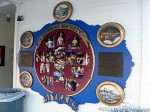 After the war, changes begun long before were even more apparent. Many of those little river towns now had their own theaters and the residents of those that didn’t had cars to drive to someplace that did. Captain Reynolds kept his family and boat afloat through contracts with universities who used the Majestic in summer theater projects. Reynolds died in 1959 just months after selling the showboat to Indiana University. The boat spent a couple of years, still working, tied up in Jeffersonville, Indiana, after the Safety at Sea Act of 1965 brought an end to traveling the river with cast and crew aboard. In 1967, the City of Cincinnati bought the boat and a long run of University of Cincinnati student performances began. Since 1991, the floating theater has been operated by Cincinnati Landmark Productions. More detailed histories of the Showboat Majestic can be found on CLP’s website and elsewhere. Those plaques on the bulkhead proclaim the boat an Historic Place and a National Historic Landmark.
After the war, changes begun long before were even more apparent. Many of those little river towns now had their own theaters and the residents of those that didn’t had cars to drive to someplace that did. Captain Reynolds kept his family and boat afloat through contracts with universities who used the Majestic in summer theater projects. Reynolds died in 1959 just months after selling the showboat to Indiana University. The boat spent a couple of years, still working, tied up in Jeffersonville, Indiana, after the Safety at Sea Act of 1965 brought an end to traveling the river with cast and crew aboard. In 1967, the City of Cincinnati bought the boat and a long run of University of Cincinnati student performances began. Since 1991, the floating theater has been operated by Cincinnati Landmark Productions. More detailed histories of the Showboat Majestic can be found on CLP’s website and elsewhere. Those plaques on the bulkhead proclaim the boat an Historic Place and a National Historic Landmark.
My own first contact with the Majestic came early in the University Of Cincinnati era when my wife and her sisters, undoubtedly through some UC contacts, organized an on board birthday party for their mother. The family did not buy out the theater but did buy a few rows and guests were able to hang out after the performance eating cake and drinking sangria. I attended another performance or two in the 1970s then sort of forgot about the theater. Oh, I knew it was there, I saw it often enough, but I took little notice of it until reminded of it by someone on another boat. It was July 2009 and I was staying on the Delta Queen for the first time. The historic steamboat had docked in Chattanooga just a month before and many of the traveling workforce, including entertainers Laura Sable and Bill Wiemuth, were still aboard. As we bemoaned the status of the Queen, Laurel pointed out the treasure that Cincinnati still had with the Majestic. I did attend a performance on the showboat early the next season but Wednesday’s was my first since then and apparently my last.
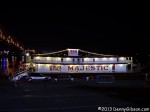 The show was fantastic. Showboat Follies! contains glimpses of all aspects of Showboat Majestic‘s history with plenty of Cincinnati’s past and present mixed in. It took some incredibly creative people to put it together and it was delivered by a wonderfully talented cast. The performance today, September 29, 2013, will be the last for Cincinnati Landmark Productions on board the Majestic. It is not because I haven’t attended more shows. They have been operating at over 80% capacity for some time now. A new theater, which can be used year round, is being built and will allow the company to deal more with performance issues and less with keeping their theater from sinking or floating away. Leaving the Majestic has not been an easy decision and it is obvious that the boat will be missed. Near the end of Wednesday’s show, CLP’s Artistic Director, Tim Perrino, came on stage to talk with the audience about the move. I sensed approaching tears more than once while he spoke and that was with four more shows on the schedule. I predict a lot of wet cheeks this afternoon.
The show was fantastic. Showboat Follies! contains glimpses of all aspects of Showboat Majestic‘s history with plenty of Cincinnati’s past and present mixed in. It took some incredibly creative people to put it together and it was delivered by a wonderfully talented cast. The performance today, September 29, 2013, will be the last for Cincinnati Landmark Productions on board the Majestic. It is not because I haven’t attended more shows. They have been operating at over 80% capacity for some time now. A new theater, which can be used year round, is being built and will allow the company to deal more with performance issues and less with keeping their theater from sinking or floating away. Leaving the Majestic has not been an easy decision and it is obvious that the boat will be missed. Near the end of Wednesday’s show, CLP’s Artistic Director, Tim Perrino, came on stage to talk with the audience about the move. I sensed approaching tears more than once while he spoke and that was with four more shows on the schedule. I predict a lot of wet cheeks this afternoon.
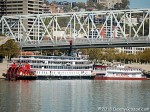 Martha won’t be back but both the Delta Queen and the Showboat Majestic could be. The City of Cincinnati has no intention of scrapping the Majestic and hopes that a new tenant can be found. In a strange twist, the US House of Representatives voted to restore the Delta Queen‘s Safety at Sea exemption just hours before I sat down for Wednesday night’s show. The bill is expected to pass the Senate and get the President’s signature. A cruising Delta Queen is still a long long way off but it is a whole lot closer than it has been in a long long time. The picture is of the Delta Queen docked next to the Showboat Majestic during the steamboat’s last visit to Cincinnati in October, 2008.
Martha won’t be back but both the Delta Queen and the Showboat Majestic could be. The City of Cincinnati has no intention of scrapping the Majestic and hopes that a new tenant can be found. In a strange twist, the US House of Representatives voted to restore the Delta Queen‘s Safety at Sea exemption just hours before I sat down for Wednesday night’s show. The bill is expected to pass the Senate and get the President’s signature. A cruising Delta Queen is still a long long way off but it is a whole lot closer than it has been in a long long time. The picture is of the Delta Queen docked next to the Showboat Majestic during the steamboat’s last visit to Cincinnati in October, 2008.

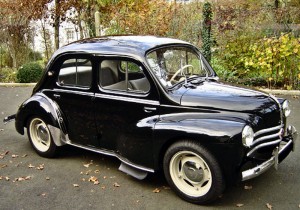

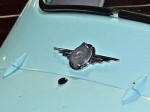



 Carl Fisher was a busy man in 1913. His Prest-O-Lite Company and his automobile dealership were both going great guns, the Indianapolis Motor Speedway he co-founded looked like it might amount to something, the Ocean-to-Ocean Rock Highway he had proposed in September of 1912 was taking off, and then there was the Indiana Automobile Manufacturers’ Association.
Carl Fisher was a busy man in 1913. His Prest-O-Lite Company and his automobile dealership were both going great guns, the Indianapolis Motor Speedway he co-founded looked like it might amount to something, the Ocean-to-Ocean Rock Highway he had proposed in September of 1912 was taking off, and then there was the Indiana Automobile Manufacturers’ Association.
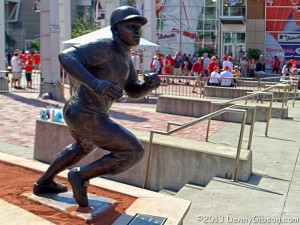

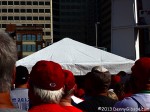



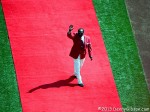
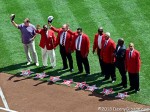
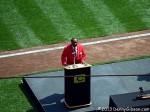
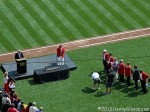

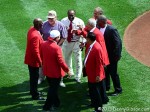
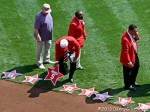

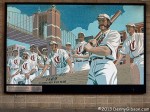
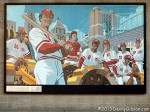
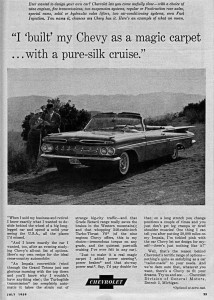
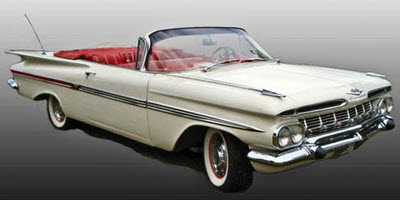 Getting back to my, I mean our, Chevy, you don’t have to imagine anything different from the car in the photo. That’s not our car but it could be. White with red interior and black top. 283 V8 with Powerglide automatic transmission. As we had planned, the car stayed with my sister while I lived in an on campus dormitory in Cincinnati — mostly. I did take the car with me for the last few weeks of the school year and I no doubt felt like one really cool dude. I don’t recall specific issues but the joint ownership thing came to an end that summer. For one thing, I decided I wanted a car with me for the next school year. I’m sure I didn’t have the money to buy out my sister and going with something that got a little better gas mileage seemed like a good idea. My sister became sole owner of the Impala but not its sole driver. I never did know all the details but there was at least one wreck when someone else was driving. I don’t believe the car was actually totaled but there was enough damage that the car went off to a new home.
Getting back to my, I mean our, Chevy, you don’t have to imagine anything different from the car in the photo. That’s not our car but it could be. White with red interior and black top. 283 V8 with Powerglide automatic transmission. As we had planned, the car stayed with my sister while I lived in an on campus dormitory in Cincinnati — mostly. I did take the car with me for the last few weeks of the school year and I no doubt felt like one really cool dude. I don’t recall specific issues but the joint ownership thing came to an end that summer. For one thing, I decided I wanted a car with me for the next school year. I’m sure I didn’t have the money to buy out my sister and going with something that got a little better gas mileage seemed like a good idea. My sister became sole owner of the Impala but not its sole driver. I never did know all the details but there was at least one wreck when someone else was driving. I don’t believe the car was actually totaled but there was enough damage that the car went off to a new home. I’ve always liked this publicity picture. It emphasizes the car’s unique appearance and offers a hint at what it might be like in the front seat. I remember what it was like in the front seat. The hood was far from short — this was a full-size American cruiser — but it could seem that way by comparison with the rest of the car. With the top down, the view in the mirror was of a rear deck that reached to the horizon and extended all the way across it.
I’ve always liked this publicity picture. It emphasizes the car’s unique appearance and offers a hint at what it might be like in the front seat. I remember what it was like in the front seat. The hood was far from short — this was a full-size American cruiser — but it could seem that way by comparison with the rest of the car. With the top down, the view in the mirror was of a rear deck that reached to the horizon and extended all the way across it.